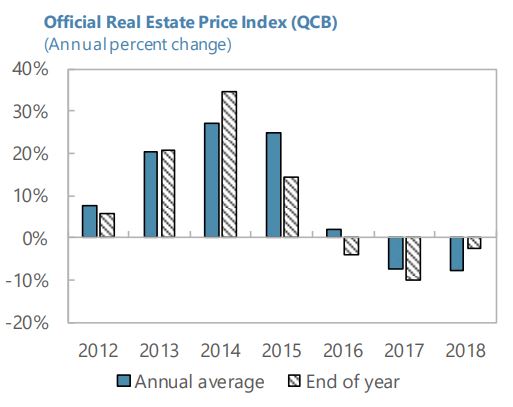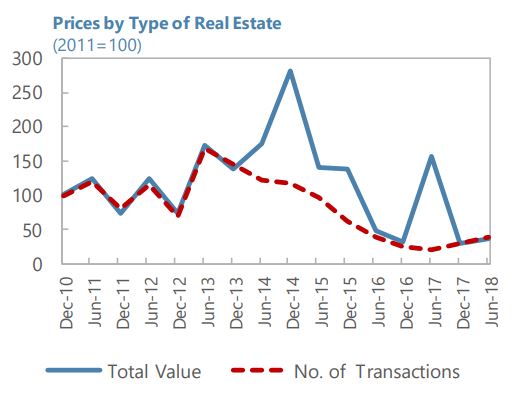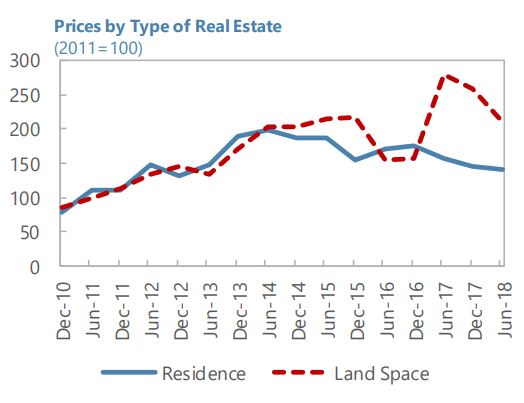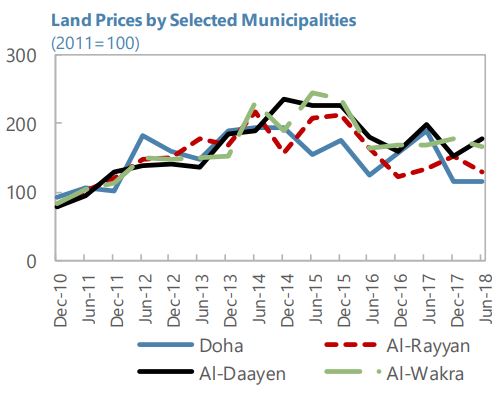Thursday, June 6, 2019
Understanding Housing Finance: Views from Susan Wachter
Global Housing Watch Newsletter: May 2019
Susan Wachter is the Albert Sussman Professor of Real Estate and Professor of Finance at The Wharton School of the University of Pennsylvania. In this interview, Wachter talks about her work on housing finance in the U.S., the housing finance revolution, the impact of new borrowing constraints on homeownership, and more.
Before, during, and after the housing bubble…
Hites Ahir: “The American mortgage in historical and international context” is a paper that you co-authored with Richard Green. It is one of your most cited papers. Could you tell us a bit about this paper?
Susan Wachter: Richard and I identified the “American Mortgage,” the 30-year fixed-rate self-amortizing mortgage without prepayment penalty, as unique and explained its historical sources. The Great Depression was in part a housing finance crisis; as the then prevailing short-term “bullet” loans came due with no financing available, they triggered an unprecedented number of foreclosures. The response first from the Home Owners’ Loan Corporation (HOLC) and later enshrined in the new Federal Housing Administration (FHA), was to institute the new mortgage instrument, the forerunner of the American Mortgage, that would not be subject to such shocks, that would be affordable, and that would support rather than undermine systemic stability.
Hites Ahir: “The housing finance revolution” is another paper that you co-authored with Richard Green in 2007, just around the time of the Great Financial Crisis. The paper examines the institutional changes in housing finance in industrialized countries. What did you find in this paper and how do the findings tie in with the housing boom of 2000-06?
Susan Wachter: The housing finance revolution, the integration of mortgages into global financial markets, as defined here, came about in the aftermath of crises in the Savings & Loan industry and similar institutions elsewhere. Many countries across the globe segmented housing finance from capital markets prior to the 1980s. With global inflation, the banking industry’s colloquial “3-6-3 rule”—pay depositors 3 percent, lend at 6 percent, and golf at 3 o’clock—could no longer work, as money market funds offered rates far higher than the 6 percent. The Savings & Loan industry hemorrhaged deposits and ultimately failed due to this asset-liability mismatch: long-term mortgages could not be funded by short-term deposits. Securitization provided an alternative source of funds accessed from global capital markets, through the government-sponsored enterprises Fannie Mae and Freddie Mac. The housing finance revolution, the move from segmented and regulated S&L lending to mortgage-backed securities—integrated with global capital markets but still regulated through the GSEs—was followed by a deregulation of securitization. The deregulation led to the proliferation of unregulated private-label mortgage-backed securitization which funded risky loans that were poorly underwritten and underpriced for risk. These loans funded the housing boom of 2000 to 2006.
Hites Ahir: You have tried to explain the housing bubble with Adam Levitin. In a nutshell, what is the explanation?
Susan Wachter: The bubble was the result of a shift in mortgage finance from regulated securitization by Fannie Mae and Freddie Mac to unregulated securitization by Wall Street banks. Housing is uniquely vulnerable to credit-fueled bubbles because it cannot be directly shorted and because of the correlated nature of home prices. Accordingly, the market’s stability has always depended on regulation of underwriting standards. Those underwriting standards helped establish the dominance of the 30-year fixed rate mortgage, a uniquely American product that has been the bedrock of middle-class homeownership and contributed to financial stability. The shift from regulated Fannie/Freddie securitization to unregulated Wall Street securitization led to a race to the bottom in underwriting standards as banks competed for market share. The result was an oversupply of underpriced credit, marked by a shift from the traditional 30-year fixed to exotic products resembling pre-Depression “bullet loans.” With credit constraints loosened, borrowers were able to bid up housing prices, which pushed up the price of neighboring properties because of price correlation. Higher home prices made mortgages on those properties look safer, thus encouraging more lending. Yet the credit-fueled rise in home prices was unsustainable for more than a few years because of the limit on demand for homeownership. Once the newly unconstrained demand was tapped, home prices peaked, and the price correlations that make housing so susceptible to credit bubbles now operated in reverse to produce a devasting downward spiral in home prices and mortgage defaults that sparked the 2008 financial crisis.
Hites Ahir: 12 years later—it is 2019, what is the current state of housing finance in the U.S.?
Susan Wachter: The overall economy has more than recovered, and inflation-adjusted housing prices are near their 2006 highs, but, supported by low interest rates and high rents, they are not in bubble territory. Nonetheless, echoes of the crisis remain. More than 10 years after the U.S. government placed the GSEs—government-sponsored enterprises—into conservatorship, they remain in limbo. The major unfinished business of the Great Recession is the reform of the housing finance system and particularly Fannie Mae and Freddie Mac which together with Ginnie Mae today provide 70 percent of the financing for the housing market, with taxpayers at risk.
Housing finance and homeownership
Hites Ahir: Are there limits to housing finance in promoting homeownership?
Susan Wachter: Yes, there are limits: housing finance systems can lower the cost of funds, through efficient market pricing of interest rate risk and default risk, and by limiting systemic risk, preventing underwriting standards from deterioration and leverage from excessive growth in the good times, as I discuss here. But beyond this, if mortgage interest rates pro-cyclically underprice risk, perhaps in an attempt to lower the cost of lending, the result will be a higher cost of lending as the resulting instability gets priced into future housing finance lending.
Hites Ahir: With Roberto G. Quercia and George W. McCarthy, you assessed the impact of affordable lending efforts on homeownership rates. What is the verdict?
Susan Wachter: Yes, it is possible to cross-subsidize lending rates. The profit rate on loans does not have to be similarly high for all lending segments of the market, adjusting for risk. Pooling for risk is efficient due to diversification gains, and high-end borrowers may willingly join in, resulting in a stable pool even with cross-subsidies.
Hites Ahir: After the Great Recession, mortgage lending became stricter. How have the new borrowing constraints changed U.S. homeownership rates?
Susan Wachter: The evidence is that homeownership rates, particularly among millennials, are lower, in part due to FICO score and other requirements that go beyond levels that prevailed before the crisis. While renting is a choice and a good choice for many, some households are constrained, that is they may prefer to be homeowners, and may pay more as renters, but they cannot qualify to be homeowners. This is a concern particularly in gentrifying markets, since homeownership can provide a hedge against rent increases and enable households to stay in markets that optimize their lifetime opportunities.
Looking back and ahead
Hites Ahir: I looked at the list of refereed papers that you have published over the years. “The Impact of Agricultural Prices on Inflation” is your first refereed paper, published in 1975. However, your first paper on housing markets appears about 10 years later—“Residential Real Estate Brokerage: Rate Uniformity and Moral Hazard” in 1987. What triggered your interest in housing markets?
Susan Wachter: I have always been interested in land markets and in policy. That paper, which was the subject of my PhD thesis, was recently updated in a 2016 jointly co-authored paper with Davide Furceri, Prakash Loungani, and John Simon—“Global Food Prices and Domestic Inflation: Some Cross-Country Evidence.” I was and still am fascinated by what we can learn by global comparisons. But having a family meant a period of domestic interest in both senses of the word.
Hites Ahir: You have written a lot about housing markets, especially housing finance. What would be the top five papers on housing finance that I should read?
Susan Wachter: My early work with Richard Herring, “Real Estate Booms and Banking Busts,” shows how banks respond to booms by their lending practices, accelerating booms into bubbles. Several papers with Andrey Pavlov take this further and point to banks’ incentivizing borrowing when they underprice the option to default which is imbedded in mortgages. “Subprime Lending and Real Estate Prices” shows how this lower cost of lending led to higher house prices in the US bubble. “Mortgage Put Options and Real Estate Markets” derives a bubble indicator, the correlation of a decline in the credit risk premium with price rises, adjusted for fundamentals, and shows how this indicator is associated with the severity of price declines after prices peak across many countries. Finally, an article I wrote for the National Institute of Economic and Social Research (NIER), “The Market Structure of Securitisation and the US Housing Bubble,” shows how all financial institutions that lend to real estate are impacted by unsustainably risky lending that leads to correlated real estate price declines and, through financial contagion effects, systemic risk. This sets up the need for macro prudential policy. For a comprehensive account of the rise and collapse in home prices that sparked the 2008 financial crisis, see The Great American Housing Bubble, co-authored with Adam Levitin, forthcoming, Harvard University Press.
Hites Ahir: What kind of questions would you like future research on housing finance to address?
Susan Wachter: Global finance and housing finance are now integrated and will continue be so going forward. How do nations address the inevitable housing finance and housing affordability challenges, in an era of an increasing attraction of urban centrality, and consequently higher housing prices, in developed and emerging economies? Housing finance, macro instability, and the new affordability concerns together raise important questions—ones that we in the housing finance community can address to help inform social and financial stability policies across nations.
Photo by Breno Assis
Global Housing Watch Newsletter: May 2019
Susan Wachter is the Albert Sussman Professor of Real Estate and Professor of Finance at The Wharton School of the University of Pennsylvania. In this interview, Wachter talks about her work on housing finance in the U.S., the housing finance revolution, the impact of new borrowing constraints on homeownership, and more.
Posted by at 2:30 PM
Labels: Global Housing Watch
Housing View – June 6, 2019
On cross-country:
- Making Affordable Housing a Reality in Cities – World Economic Forum
- How Airbnb became key to turning homes into businesses – Financial Times
- European city living gets less affordable – Financial Times
- Architects look to floating cities as sea levels rise – Financial Times
On the US:
- Affordable Housing and City Welfare – NBER
- Cory Booker unveils plan to combat housing ‘affordability crisis’ – CNN, Los Angeles Times and New York Times
- Like college debt and climate change, the housing affordability crisis is generational warfare – Slate
- Charts of the week: Housing markets – Brookings
- Why Some Americans Won’t Move, Even for a Higher Salary – Citylab
- How California’s big plans to address housing affordability crashed – Los Angeles Times
- Escaping the Housing Shortage – Federal Reserve Bank of Kansas City
- How Luxury Units Turn Into Affordable Housing – Citylab
On other countries:
- [China] China Curbs Property Developers’ Funding to Cool Land Prices – Bloomberg
- [Germany] Stress testing the German mortgage market – Deutsche Bundesbank
- [Germany] Germany’s house price growth accelerates – Global Property Guide
- [Hong Kong] Hong Kong’s house price boom is over – Global Property Guide
- [Ireland] Ireland’s house price rises continue, albeit at a much slower pace – Global Property Guide
- [New Zealand] Controlling house price affordability: Look to the rental market – Massey University
- [Portugal] Portugal’s housing market is strengthening – Global Property Guide
- [Slovak Republic] Slovak Republic’s house price rises continue – Global Property Guide
- [Syria] The architects with radical designs for rebuilding Syria – Financial Times
- [United Kingdom] Behind the housing crisis – Property Journal
- [United Kingdom] Is building more houses the answer? – Property Journal
On cross-country:
- Making Affordable Housing a Reality in Cities – World Economic Forum
- How Airbnb became key to turning homes into businesses – Financial Times
- European city living gets less affordable – Financial Times
- Architects look to floating cities as sea levels rise – Financial Times
On the US:
- Affordable Housing and City Welfare – NBER
- Cory Booker unveils plan to combat housing ‘affordability crisis’
Posted by at 3:00 AM
Labels: Global Housing Watch
Wednesday, June 5, 2019
Animated chart of US oil production by state, 1981-2018
From American Enterprise Institute:
“A big thanks to my former AEI colleague Olivier Ballou for helping me find the UK-based website Flourish, which allowed me create the “bar chart race” visualization above showing annual oil production (barrels per day) in the top ten oil-producing states (including federal offshore production) from 1981 to 2018. Perhaps the most interesting trend is to watch the rise of oil production in North Dakota. The state ranked No. 10 until about 2005, when revolutionary drilling and extraction technologies tapped into previously inaccessible shale oil deposits in the Bakken Formation in western North Dakota, and the state then rose to the No. 2 oil-producing US state by 2015 behind only Texas (and offshore production). Also notice the significant declines in conventional oil production in Alaska (from more than 2 million barrels per day in 1988 to below 500,000 bpd by 2014) and California (from more than 1 million bpd in the early 1980s to below 500,000 bpd in 2017).
The Flourish website is pretty user-friendly and I’ll try to produce more “bar chart race” visualizations in the future. If you have any ideas, please leave them in the comment section.”
From American Enterprise Institute:
“A big thanks to my former AEI colleague Olivier Ballou for helping me find the UK-based website Flourish, which allowed me create the “bar chart race” visualization above showing annual oil production (barrels per day) in the top ten oil-producing states (including federal offshore production) from 1981 to 2018. Perhaps the most interesting trend is to watch the rise of oil production in North Dakota.
Posted by at 9:03 AM
Labels: Energy & Climate Change
Monday, June 3, 2019
Stranded! How Rising Inequality Suppressed US Migration and Hurt Those Left Behind
From an IMF working paper by Tamim Bayoumi and Jelle Barkema:
“Using bilateral data on migration across US metro areas, we find strong evidence that increasing house price and income inequality has reduced long distance migration, the type most linked to jobs. For those migrating uphill, from a less to a more prosperous location, lower mobility is driven by increasing house price inequlity, as the disincentives from higher house prices dominate the incentives from higher earnings. By contrast, increasing income inequality drives the fall in downhill migration as the disincentives from lower earnings dominate the incentives from lower house prices. The model underlines the plight of those trapped in decaying metro areas—those “left behind”.”
From an IMF working paper by Tamim Bayoumi and Jelle Barkema:
“Using bilateral data on migration across US metro areas, we find strong evidence that increasing house price and income inequality has reduced long distance migration, the type most linked to jobs. For those migrating uphill, from a less to a more prosperous location, lower mobility is driven by increasing house price inequlity, as the disincentives from higher house prices dominate the incentives from higher earnings.
Posted by at 5:08 PM
Labels: Inclusive Growth
Qatar: Property Market Update
From the IMF’s latest report on Qatar:
“After a period of rapid growth, real estate prices in Qatar are adjusting to new levels. According to the real estate price index developed by QCB, following an 82 percent increase during 2012–16, real estate prices fell by 15 percent during 2017–18. Data produced by the Ministry of Justice indicate the following trends:
- Both the volume and number of transactions are down since 2013–2014 peak. As prices have decreased, some owners seem to be holding off to their properties rather than selling at depressed prices.
- Land prices are holding up better than properties with a rebound in prices during 2017 before adjustment in 2018. Residence prices have been on a declining trend since mid-2014, though there are signs that the slowdown is flattening.
- In terms of regions, land prices in Al Daayen are holding on better which could be due to the active development of Lusail City and 2022 World Cup projects. Similarly, land prices in Al Wakra have been stable in the past years due to major infrastructural projects.”
From the IMF’s latest report on Qatar:
“After a period of rapid growth, real estate prices in Qatar are adjusting to new levels. According to the real estate price index developed by QCB, following an 82 percent increase during 2012–16, real estate prices fell by 15 percent during 2017–18. Data produced by the Ministry of Justice indicate the following trends:
- Both the volume and number of transactions are down since 2013–2014 peak.
Posted by at 10:51 AM
Labels: Global Housing Watch
Subscribe to: Posts










